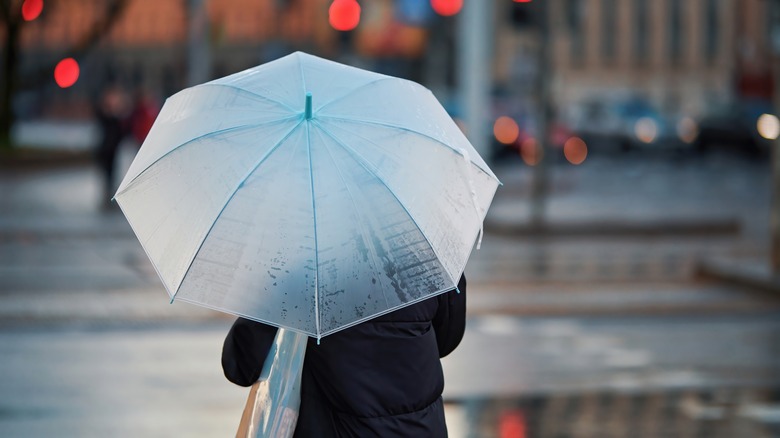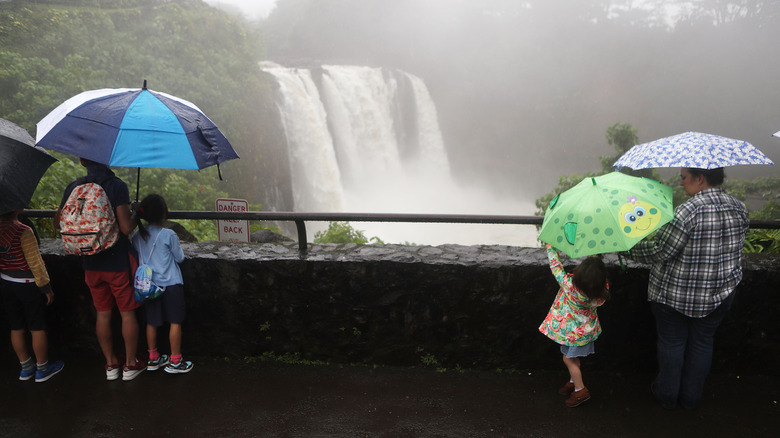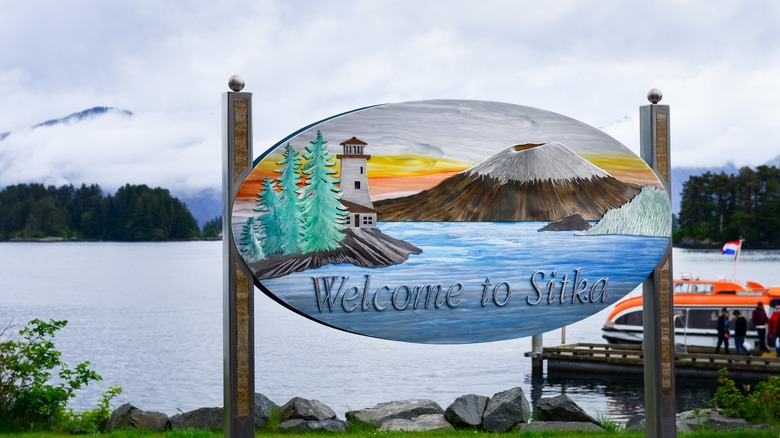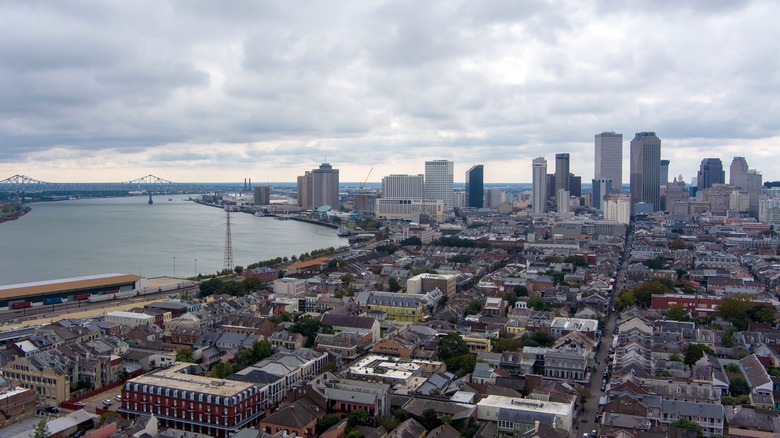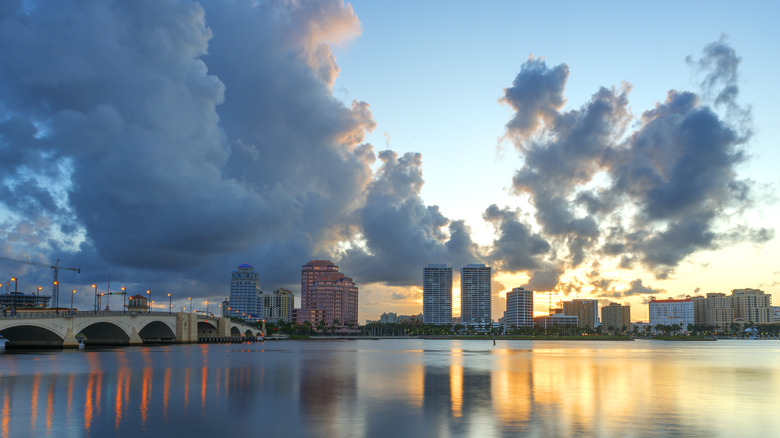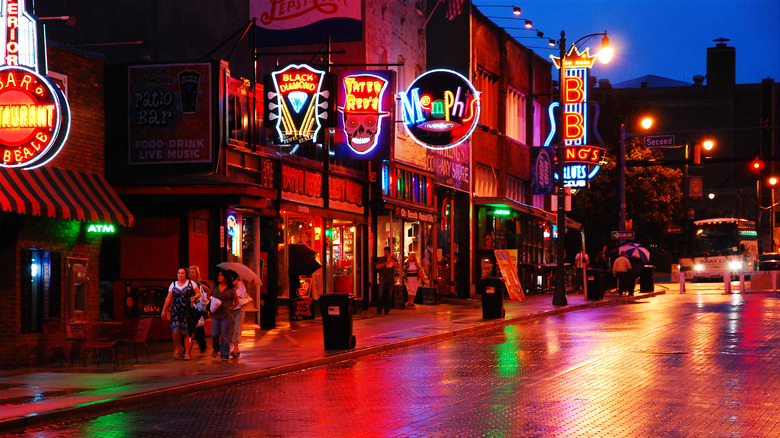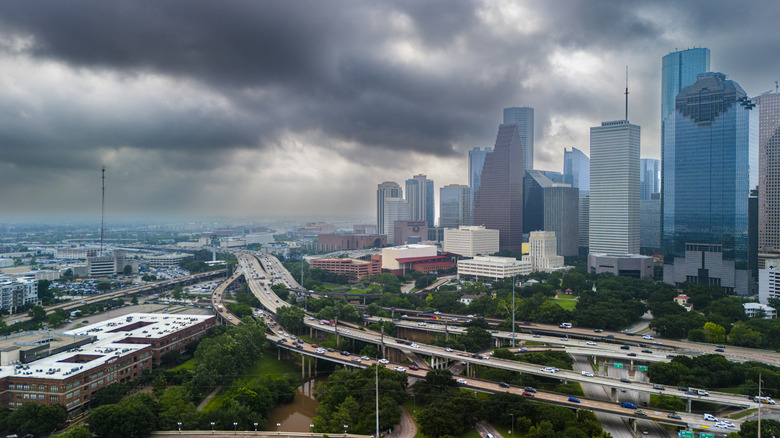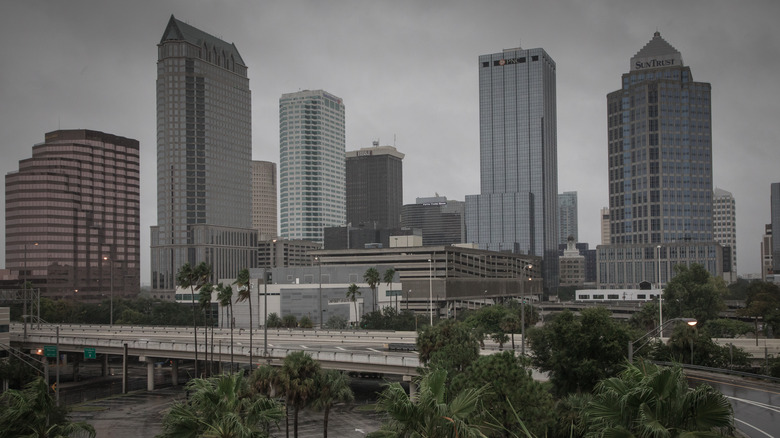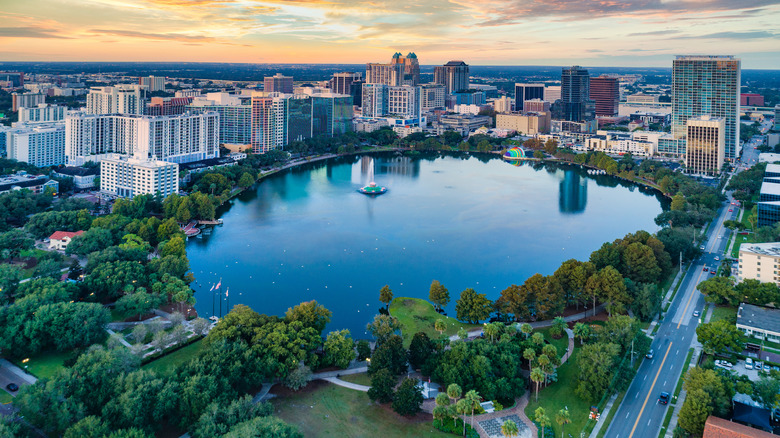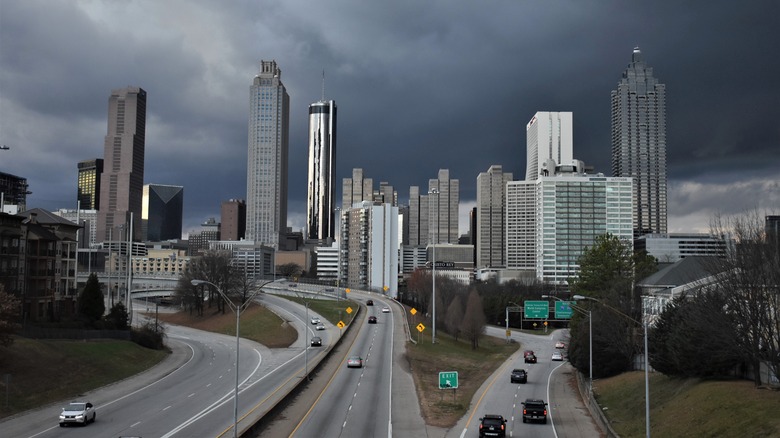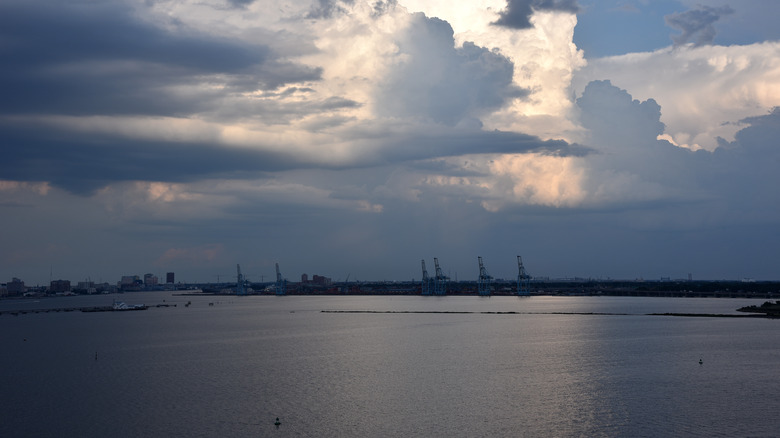The Absolute Rainiest Cities In The United States
Depending on where you live, your region might be rainier or drier than other parts of the country. You might also see rain evenly throughout all four seasons, or perhaps a bit more during spring and summer storms. On top of this, the occasional tropical system can increase rainfall totals for the year.
While differences from climate change are bringing wetter weather to certain parts of the country, some cities in the U.S. have a long-standing reputation for getting the most rain overall. For that matter, while Seattle has a reputation for having many rainy days per year, it falls behind other major cities in terms of average annual rainfall with its 39 inches of precipitation per year.
As you read through the rainiest cities in the United States, keep in mind that these are based on total average rainfall totals. This doesn't account for the number of wet days in a given year, although some of these cities have lots of rain and wetter weather more generally. Also, based on changing climate patterns and tropical systems, some of these cities may be wetter or drier some years than others. The bottom line though: The following cities tend to see some of the largest annual rainfall totals. (Also, if you want to learn about opposing climates, check out the driest places on Earth with the least rain.)
Hilo, Hawaii, is an extremely rainy city
Hawaii has a reputation of being paradise, and rightly so. From its beautiful beaches to lush rainforests, this island chain is home to several diverse climates. While you certainly have the opportunity to catch some sunshine, there's also a fair amount of rain to dodge depending on which island you're on, and which side. The windward (east) sides of the islands are affected by trade winds that blow off the Pacific Ocean and create more rainfall along the way. If you've ever been to Hilo, you know that this side of the Big Island of Hawaii is much wetter than its leeward (west) side.
Hilo also happens to receive the most annual rainfall totals of any U.S. city. On average, Hilo gets more than 120 inches of rain per year. What's more, this tropical city sees 267 days of rainfall on average. Despite its reputation for being the rainiest city in the country, Hilo has also experienced some drier changes in recent years. In fact, 2025 has been one of the driest years for the region. Overall, scientists believe Hawaii is getting drier, and there's also been an increased incidence of tropical downpours and flooding when it does rain. The importance of rainwater has really just been highlighted by all of this, and its changes in both volume and frequency can lead to a multitude of issues for local residents.
Sitka, Alaska, is a remote city that sees a lot of precipitation
Behind Hilo, there's another rainy city in the country that is also outside of the continental U.S. Sitka, Alaska, is situated along the outer coast of the Inside Passage that's famous for commercial and personal boat traffic. The city also happens to be a part of Tongass National Forest, which is both the largest of all national forests, a well as the world's biggest temperate rainforest (which is actually quite different from a rainforest). Sitka is in fact so much situated into the natural landscape that you can only access the city by boat or plane.
Sitka is also known for its reputation as another extremely wet city. On average, this southeastern Alaskan city gets nearly 90 inches of total precipitation every year, and while Sitka does get snow, most of this precipitation is actually rainfall. The official rainy season occurs between the months of September and November. However, October is usually the wettest month on average.
Miami, Florida, is a tropical city with lots of rain
Most of the state of Florida is considered subtropical, while southern portions of the state have tropical climates. These southern areas of Florida typically experience drier winters and lots of sunshine, along with higher amounts of rain during afternoon thunderstorms in the late spring to early fall. In fact, while Florida is in fact known for its abundant sunshine, it also has its fair share of rain; the state is even home to some of the rainiest cities in the country. Miami is one such major U.S. city that consistently has a lot of rainfall every year.
In 2024, Miami saw nearly 70 inches of rain, which was above the estimated 67 inches per year. Also, while Florida consistently leads the pack in terms of most lightning strikes in the country, Miami was crowned the number one spot out of all U.S. cities in 2023. The Miami region experienced nearly 121,000 strikes during that year alone. That same year, Miami also had higher-than-average rainfall totals of 83 inches.
New Orleans, Louisiana, experiences a lot of rain and flooding
"The Big Easy" is well known for jazz music, culture, food, and the annual Mardis Gras festival. But you should probably consider adding rain to this list. New Orleans gets a lot of moisture thanks in part to its close proximity to the Mississippi River Basin, which has been experiencing extreme weather patterns in recent years. With an average of 63 inches of rainfall per year, New Orleans is considered among the rainiest cities in the U.S. Unfortunately, New Orleans is also prone to floods due to its lower elevation. Such geographical challenges were notable with the devastation unleashed during Hurricane Katrina in 2005, where the surrounding levees were overwhelmed by a devastating storm surge and more than 10 inches of rain.
Aside from the impact of natural disasters like Hurricane Katrina, New Orleans has to also contend with the effects of torrential rainfall from time to time. The fact that the city sits below sea level is problematic enough during a hurricane, but it can also cause issues whenever the region's notorious downpours occur. Such rain events can sometimes lead to several inches falling per hour.
What's more, flooding events from torrential downpours are becoming more frequent in New Orleans. Scientists believe these severe rain events are linked with climate change, and they're expected to increase. In other words, this could possibly mean that the area's average rainfall totals might rise even more in future years.
West Palm Beach is another rainy city on Florida's east coast
While Miami is Florida's rainiest city, it has a close competitor for this title. West Palm Beach gets about 132 days of rain every year, and it's a part of the southeastern portion of Florida that is known for being one of the rainiest regions in the state. Located just north of Miami, this other coastal city gets an average of 62 inches of rain per year.
Also like Miami, West Palm Beach is known for its beaches, as well as its outdoor entertainment and arts, though it's considerably more relaxed and family-friendly, and you're more likely to see retirees in this city. But this doesn't mean you won't have to dodge rainfall in West Palm Beach. You should expect more frequent rain during the months of May through October, along with high heat and humidity. Much of this rainfall comes in the form of afternoon thunderstorms, which can catch visitors and new residents off guard as they're on the beach or walking around downtown.
Birmingham, Alabama, experiences rain throughout the year
The state of Alabama is no stranger to severe weather events, including tornadoes and severe thunderstorms. Its climate is attributed to its location,; its latitude makes it rather prone to dramatic shifts in temperature as the seasons change, and its proximity to the Gulf of Mexico tends to make the weather warm and humid throughout a large part of the year. Multiple cities in Alabama also see large rainfall totals per year. This includes Birmingham, which gets nearly 57 inches of rain per year on average.
That said, more coastal areas in Alabama can see far more destructive weather patterns than what's seen in Birmingham. In fact, this Appalachian city is largely protected from some of the direct impacts of hurricanes compared with other cities along the Gulf that might see related rain events. However, what makes this city feel rainier is the fact that the precipitation is spread more evenly throughout the year, quite unlike a city that might experience most of its rainfall during the spring or summer months. Rainfall isn't distributed perfectly evenly throughout the year, though;, Birmingham tends to see more rain between March and July, and the least amount in October.
Memphis, Tennessee, experiences moisture fueled by the Mississippi River
Located in the southwestern part of Tennessee, Memphis is known for its rich culture, particularly when it comes to music. Along with being considered the birthplace of rock and home to the blues, the city also has an interesting climate. This is all thanks to its position along the Mississippi River, which creates more moisture. Overall, Memphis sees about 55 inches of rainfall per year, along with an average of 3 inches of snow.
Not only can you find numerous types of aquatic plants and animals in the Mississippi River, but this famous body of water is the main contributor to the city's typically wet and humid conditions. In fact, average rainfall totals are generally a bit lower as you get further away from the Mississippi River, towards northern parts of Tennessee.
More generally, Memphis can experience heavy rainfall events and thunderstorms in the spring and summer months, but there's been an uptick in tropical downpours in recent years. Climate change-fueled rainfall excesses have also led to flooding concerns in Memphis.
Houston, Texas, has witnessed record rain and snow in recent years
The overall average rainfall for this large Texas city is nearly 52 inches per year. So it seems fitting that Houston would have a reputation for rain, heat, and humidity, but it can also get cold and icy during the winter months. Measurable snowfall is rare for the area, but a rare January 2025 event did bring 6 inches of snow to Houston. Aside from this historic event, however, most of Houston's precipitation is attributed to rainfall.
Notably, the impacts of tropical systems have contributed to Houston's annual rainfall totals in recent years. Hurricane Harvey is the most notorious example, and this system is still considered the wettest one on record for the U.S. While originally making landfall in the coastal city of Rockport, Harvey's effects extended all over southeast Texas, bringing over 50 inches of rain within a week in some areas. Houston was particularly affected with relentless rain and devastating flooding. Overall, because of Harvey, Houston saw 79.69 inches of rain that year total, making it the rainiest year on record.
Tampa is a rainy spot on Florida's west coast
While the east coast of Florida tends to get more precipitation, cities along the west coast can also get a lot of rain per year. Tampa is one such city, where the average rainfall totals are above 52 inches annually. More generally speaking, the area of Tampa Bay usually sees the most rainfall between July and early September, along with some strong thunderstorms. This is also the time of year when flooding is also a concern.
Beyond that, though, Tampa has seen some significant rainfall totals in recent years due to tropical systems. 2024 was one such year, where the city received over 80 inches of rain! The above-average rainfall was attributed to numerous downpours during the annual summer rainy season, as well as from tropical systems. In particular, both Hurricane Debby and Hurricane Milton contributed to Tampa's high rainfall totals. In all, 2024 was considered a record-breaking year in terms of overall precipitation.
Orlando, Florida, is another rainy part of the Sunshine State
Orlando, Florida, is arguably best-known for are theme parks. Given Florida's moniker "the Sunshine State," out-of-towners might book their theme park vacations with the expectation that their experiences will be warm and sunny. However, it's very common to go to a theme park on a sunny morning only to try and find shelter in the afternoon or evening when sudden rain hits. In fact, rainfall is very characteristic of this region. Overall, Orlando sees about 51 inches of rain on average each year.
As with other parts of Florida, most of Orlando's rainfall totals come from the summer months during thunderstorm season. During this time of year, the city experiences more than 23 inches of rainfall on average. This is more than three times the amount during the winter dry season. In fact, Orlando sees just about 7 inches of total rain during the winter months. Interestingly, the overall rainfall totals for the area have creeped up based on data collected between 1991 and 2020. Needless to say, whether you live in Orlando or are visiting, it's always a good idea to have an umbrella handy. This is true whether you're wanting to do science projects on theme park rides, or whether you're enjoying the arts and culture of the area.
Atlanta, Georgia, can be both hot and rainy
Known by its nickname "Hot-lanta" due to the region's sweltering summers, Atlanta experiences several days of 80 to 90 degree temperatures. In fact, the National Weather Service says that the area experiences over 90-degree temps at least 30 to 60 days every year. Atlanta also sees its fair share of rain. North Georgia — which includes the Atlanta metro area — gets around 50 inches of rainfall per year. In fact, Atlanta has about 117 days a year of precipitation.
Rainfall can occur almost any time of the year in Atlanta, although September and October are typically the area's driest months. Spring and summer thunderstorms are typical, where the area can experience tropical-like downpours from time to time. Historically though, March brings the most days of precipitation to the region, right before peak tree pollen season begins.
It's also not uncommon for Atlanta to feel the effects of tropical weather. This was the case when Hurricane Helene made its way through Georgia, bringing 11 inches of rain to the city. While the effects were incomparable to Helene's catastrophic damage to parts of western North Carolina, the amount of rain that fell from the hurricane in Atlanta was still was considered a historic event. Not only did this rain event occur during what is typically considered a drier month, it also caused major flooding in some parts of the city.
Norfolk, Virginia, can experience downpours and flooding
Virginia is yet another southern U.S. state that can see its share of both rain and snow. This includes the notable southeastern city of Norfolk. This waterfront region is located along both the Chesapeake Bay and Elizabeth River, and is within close proximity to the Atlantic Ocean. While perhaps best known for being home to the largest naval base on Earth, Norfolk also earns a spot on the list of rainiest cities in the U.S. Overall, the waterfront city sees about 49 inches of rainfall per year, plus 6 inches of snow to add to the area's precipitation total.
Unlike other cities where the rainfall is spread out evenly throughout the year, much of Norfolk's rain events come in the form of large downpours. Aside from contributing to higher annual rainfall totals, these downpours are notorious for causing other issues, too, and one in particular. Given Norfolk's proximity to multiple bodies of water, the city itself is prone to flooding when these rainfall events happen. Norfolk is also only 7 feet above sea level, which can further compound flooding problems.
